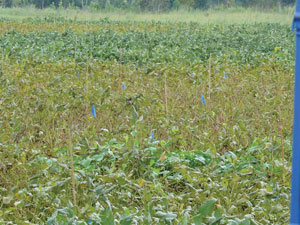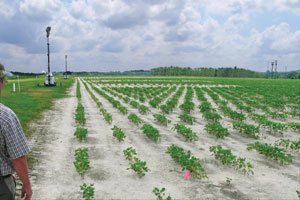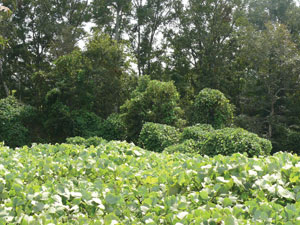
Features
Agronomy
Diseases
Soybean rust training
Ontario group heads south for closest look.
February 20, 2009 By Blair Andrews

|
|
Flags mark test plots for Asian soybean rust at the University of Florida’s Quincy Research Station. All photos courtesy of Albert Tenuta, OMAFRA. |
The familiar adage could be used to describe how Ontario’s soybean industry is meeting the potential challenges of Asian soybean rust. Although this aggressive crop disease was detected in Ontario only once late in the 2007 growing season in plots at the University of Guelph Ridgetown Campus, it is important for Canadian crop advisors, researchers and growers to keep tabs on its development in the United States. Several people from the Ontario Ministry of Agriculture, Food and Rural Affairs (OMAFRA), University of Guelph, the Ontario Soybean Growers and other crop industry representatives got much closer to soybean rust by attending a training session at the University of Florida’s Quincy Research Station.
Albert Tenuta, OMAFRA field crops pathologist, says it was a chance to see soybean rust at its height in one of the hotter spots for the disease in the US. The group also had the opportunity to view various research plots and management trials. “We’ve had germplasm trials down in Florida for the past two years where we have taken some of our crosses, from Agriculture and Agri-Food Canada in Harrow and Ottawa, as well as from the University of Guelph, Ridgetown, and are running them down there under significant disease pressure,” explains Tenuta. “We’ve also had fungicide trials down there where we have taken our registered fungicides for rust and applied them under rust pressure in Florida. So this was a great opportunity to learn about the disease, but at the same time see it up close and personal.”
The people who participated in the training learned first-hand how to scout for and identify rust in field situations. They also were able to look at the disease under a microscope and in various conditions. “The biggest take home is that it was actually an opportunity to see it in the field. You can read about it and you can look at it on websites but there’s nothing like seeing it for real,” says Crosby Devitt, research manager for Ontario Soybean Growers, who was part of the Canadian contingent.
And while the tour participants still respect that rust can inflict heavy economic damage to the crop, they came home feeling a little more confident about being able to deal with the disease whenever it may strike eastern Canada.“One of the big things that I took away from it is they see soybean rust every year in the southern US, and it’s a matter of when it affects the crop and how bad it’s going to be, ” says Leanne Freitag, an agronomist with Cargill in Princeton. “It was really good to see how they react to it. They’re not afraid.”
 |
| Ontario soybean lines are grown under lights to increase day length, alongside USDA lines. |
Different perspective than in the past
The fear concerning soybean rust has declined substantially since the disease was first detected in the United States in 2004. Education and research have gone a long way toward easing the anxiety. As the disease was making its way across South America and was heading for the United States, and with no germplasm showing resistance, it became clear to US soybean industry officials that they needed to obtain a better understanding of soybean rust. “We had to find ways to train our infrastructure. We were looking at a pathogen nobody knew and nobody knew how to identify except for a handful of individuals in the US,” says Dr. David Wright, of the Iowa Soybean Association and director of the North Central Soybean Research Program (NCSRP), which sponsors the rust training in Florida. “We had no management recommendations for it, no genetic resistance for it, so it was really scary. Our infrastructure, our scientists and our crop advisors really needed to get up to speed.”
NCSRP consists of the state soybean checkoff boards in Kansas, Illinois, Indiana, Iowa, Michigan, Minnesota, Missouri, Nebraska, North Dakota, Ohio, South Dakota and Wisconsin. Wright says its partnership with the University of Florida has fostered the development of effective management recommendations for Asian soybean rust. He says they have the tools for early detection and there are also fungicides available to help control it. “We understand it a whole lot better. There’s a whole industry that is well-trained in the possible impact of rust and its biology. And I am certainly less fearful of it today than in November 2004.”
Similar feelings are being expressed four years later by the Canadian visitors after seeing the management techniques for themselves. Devitt says the learning experience will be valuable for Ontario crop specialists in the event that Asian soybean rust crosses the border. “One of the values of having the Canadians down there was that now we have agronomists from Ontario with first hand knowledge in scouting for rust and seeing what it can do. But also we learned about control measures such as fungicides, including timing and how well they work, which I think is going to be important in case we have it in Ontario.”
Echoing Devitt’s comment on fungicides, Freitag is of the opinion that triazoles and strobilurins are effective on rust. Triazoles, found in products like Folicur and Tilt, have better activity on rust, but strobilurins, like Headline and Quadris, are stronger on some of the other leaf diseases that could be present. “There are strengths to both chemistries. The two modes of action combined will control a broader disease spectrum and will help with resistance management, too.”

|
| The kudzu plant, a prominent host species for Asian soybean rust, can be found growing extensively around fields. |
Need to remain diligent
While Freitag, Devitt and other members of the Canadian contingent are more confident about the industry’s ability to respond to an outbreak, they also stress that the industry should not get complacent. In addition to learning about rust identification and control, Tenuta says the group saw the need to be vigilant about this disease, which is still in its infancy in North America. “Soybean rust is evolving. We still have a lot to learn. It can be managed, but we have to be proactive in managing it,” notes Tenuta. “One of the events that really took people aback was the look at the kudzu plots, the main overwintering host of soybean rust in the US, and how well it is infected. Just the difficulty in scouting and managing it in the early phases was something the participants gained a whole new appreciation for.”
While less fearful of the disease, Wright also notes that there is still much to be learned about rust, stressing that it is a pathogen that causes serious economic loss. “We still don’t understand how severe it may become in our upper soybean producing areas. It is definitely severe in Florida,” says Wright. “But we do have the know-how to monitor its movement throughout the United States. We’re still working on other tools to help us detect it early.”
As the industry expands its knowledge of the disease, Wright recommends people pay attention to the messages from university extension and crop specialists about soybean rust. Ontario is part of the North American soybean rust early warning sentinel plots system. Through the efforts of Dr. Sarah Hambleton of AAFC in Ottawa and Tenuta with OMAFRA, soybean rust spores are consistently trapped in the province each year from June through September. The appearance of the spores does not mean the disease is present. However, the potential for an outbreak exists, depending on the amount of spores and environmental conditions. “We have a huge infrastructure now that we’re using to monitor the movement of rust and it’s been very effective. There’s a wonderful working relationship between OMAFRA, Canadian scientists and the Ontario Soybean Growers, working closely with their counterparts in the United States. I think it’s a great model for future activities,” says Wright.
About 25 Canadians joined their industry counterparts from Nebraska, North Carolina, Missouri and South Dakota for the training session that was held September 18-19, 2008. Funding for the trip was provided by a grant from Agricultural Adaptation Council’s CanAdvance program. It was part of a three-year project for soybean rust education and communication.